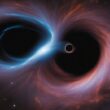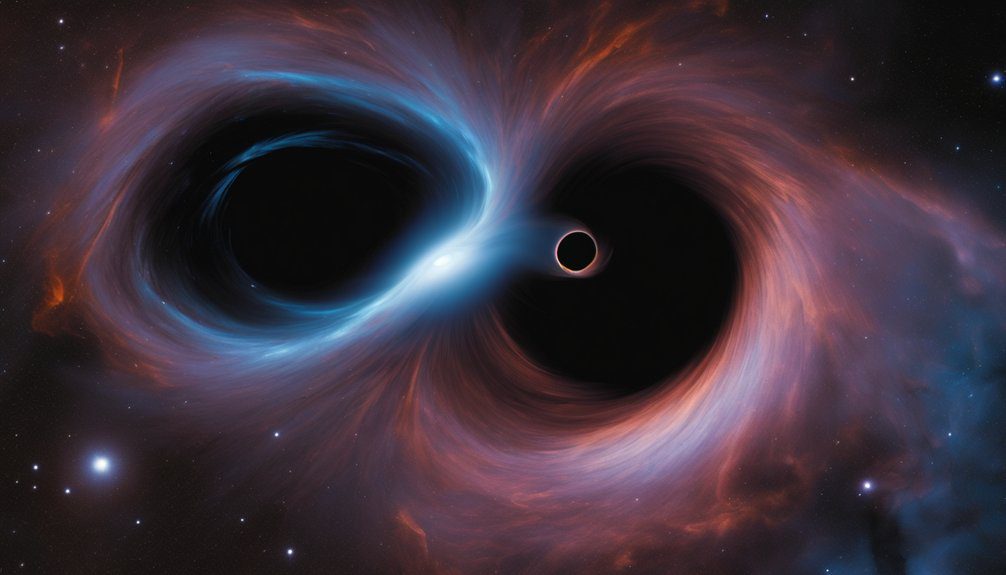Ton 618 is a quasar located about 10.37 billion light-years away in the constellation Canes Venatici. It hosts an ultramassive black hole estimated to be 66 billion times the mass of the Sun, with an event horizon stretching roughly 195 billion kilometers across. This black hole’s extreme size challenges our understanding of black hole growth and cosmic evolution. By exploring Ton 618, you’ll uncover important insights into how such monstrous black holes influence the universe’s structure and development.
The Discovery and Location of Ton 618
Although Ton 618 was first identified in the 1950s, its significance as a black hole became clearer over time through detailed observations.
You’ll find Ton 618 located in the constellation Canes Venatici, roughly 10.37 billion light-years from Earth. It was initially discovered as a quasar, a highly luminous object powered by a supermassive black hole.
By studying its emitted light and spectral lines, scientists determined that Ton 618 isn’t just any quasar but one associated with an exceptionally massive black hole.
This discovery highlights the vast scale of cosmic phenomena you can explore in the universe.
The Astonishing Mass and Size of Ton 618
When you examine Ton 618, its mass and size immediately stand out as extraordinary. This black hole’s immense scale challenges your understanding of cosmic phenomena.
Consider these key facts:
- Estimated mass: around 66 billion times that of our Sun
- Event horizon diameter: roughly 195 billion kilometers
- Gravitational pull strong enough to trap light itself
- One of the largest known ultramassive black holes
- Its size vastly exceeds typical black holes found in galaxies
These figures highlight how Ton 618 dominates space, offering a unique example of extreme mass and size in the universe.
The Role of Ton 618 in Understanding Black Hole Evolution
Ton 618’s extraordinary mass and size provide valuable data for studying how black holes grow and evolve over time.
By examining Ton 618, you gain insights into the processes that allow black holes to accumulate mass rapidly, such as accretion and mergers. Its extreme properties challenge existing models, helping refine theories about galaxy formation and cosmic evolution.
Observing Ton 618 also illustrates how black holes influence their surroundings, affecting star formation and galactic structures.
Understanding this giant black hole gives you a clearer picture of the universe’s dynamic nature and the role these powerful objects play in shaping it.
Frequently Asked Questions
What Effects Does Ton 618 Have on Its Surrounding Galaxy?
You’ll find Ton 618’s immense gravity shapes its galaxy by pulling in gas and stars, fueling energetic jets that regulate star formation, keeping the galaxy’s growth balanced and preventing chaos from overwhelming its cosmic neighborhood.
Can Ton 618 Be Observed With Amateur Telescopes?
You can’t observe Ton 618 directly with amateur telescopes since it’s incredibly distant and bright only in X-rays and radio waves. You’ll need powerful professional instruments to study its immense presence in the cosmos.
How Does Ton 618 Compare to Other Supermassive Black Holes?
You’ll find Ton 618 massively outshines most supermassive black holes, boasting a record-breaking mass and brightness. It’s like the heavyweight champion, dominating the cosmic stage with unparalleled power and size compared to others you know.
What Would Happen if a Star Got Too Close to Ton 618?
If a star got too close to Ton 618, you’d see it torn apart by tidal forces, releasing intense energy as it spirals in. You can’t escape the black hole’s pull once you’re that near.
Are There Any Theories About How Ton 618 Formed so Quickly?
Yes, you’ll find theories suggesting Ton 618 grew fast by gobbling massive gas clouds or merging with other black holes early on, letting it defy typical growth limits and become that colossal cosmic giant in record time.






